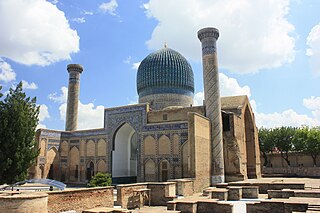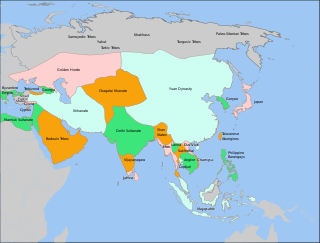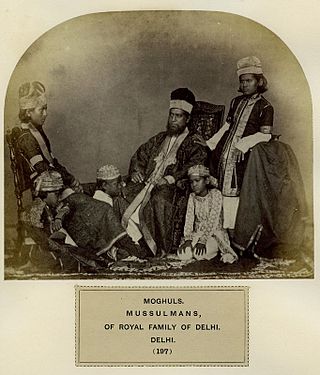Related Research Articles
The Barlas were a Mongol and later Turkicized nomadic confederation in Central Asia. With military roots in one of the regiments of the original Mongol army, the Barlas spawned two major imperial dynasties in Asia: the Timurid Empire in Central Asia and Persia; and its later branch, the Mughal Empire in the Indian subcontinent.

The Timurid dynasty, self-designated as Gurkani, was a culturally Persianate Sunni Muslim dynasty or clan of Turco-Mongol origin descended from the warlord Timur. The word "Gurkani" derives from "Gurkan", a Persianized form of the Mongolian word "Kuragan" meaning "son-in-law". This was an honorific title used by the dynasty as the Timurids were in-laws of the line of Genghis Khan, founder of the Mongol Empire, as Timur had married Saray Mulk Khanum, a direct descendant of Genghis Khan. Members of the Timurid dynasty signaled the Timurid Renaissance, and they were strongly influenced by Persian culture and established two significant empires in history, the Timurid Empire (1370–1507) based in Persia and Central Asia, and the Mughal Empire (1526–1857) based in the Indian subcontinent.

The Mughal emperors were the supreme heads of state of the Mughal Empire on the Indian subcontinent, mainly corresponding to the modern countries of India, Pakistan, Afghanistan and Bangladesh. The Mughal rulers styled themselves as Badshah or Shahanshah, a title usually translated from Persian as "emperor". They began to rule parts of India from 1526, and by 1707 ruled most of the sub-continent. After that they declined rapidly, but nominally ruled territories until the Indian Rebellion of 1857.

The Timurid Empire, self-designated as Gurkani, was a late medieval, culturally Persianate, Turco-Mongol empire that dominated Greater Iran in the early 15th century, comprising modern-day Iran, Iraq, Afghanistan, much of Central Asia, the South Caucasus, as well as most of contemporary Pakistan and parts of contemporary North India and Turkey.

The Chagatai Khanate, or Chagatai Ulus was a Mongol and later Turkicized khanate that comprised the lands ruled by Chagatai Khan, second son of Genghis Khan, and his descendants and successors. At its height in the late 13th century the khanate extended from the Amu Darya south of the Aral Sea to the Altai Mountains in the border of modern-day Mongolia and China, roughly corresponding to the area once ruled by the Qara Khitai.
Timurid refers to those descended from Timur (Tamerlane), a 14th-century conqueror:

The Gūr-i Amīr or Guri Amir is a mausoleum of the Turco-Mongol conqueror Timur in Samarkand, Uzbekistan. It occupies an important place in the history of Central Asian Architecture as the precursor for and had influence on later Great Mughal architecture tombs, including Gardens of Babur in Kabul, Humayun's Tomb in Delhi and the Taj Mahal in Agra, built by Timur's Indian descendants, Turco-Mongols that followed Indian culture with Central Asian influences, Mughals established the ruling Mughal dynasty of the Indian subcontinent. The mausoleum has been heavily restored.

Shah Rukh or Shahrukh Mirza was the ruler of the Timurid Empire between 1405 and 1447.

Sultan Husayn Bayqara Mirza was the Timurid ruler of Herat from 1469 until May 4, 1506, with a brief interruption in 1470.

The Turco-Mongol or Turko-Mongol tradition was an ethnocultural synthesis that arose in Asia during the 14th century, among the ruling elites of the Golden Horde and the Chagatai Khanate. The ruling Mongol elites of these Khanates eventually assimilated into the Turkic populations that they conquered and ruled over, thus becoming known as Turco-Mongols. These elites gradually adopted Islam as well as Turkic languages, while retaining Mongol political and legal institutions.

Moghulistan, also called the Moghul Khanate or the Eastern Chagatai Khanate, was a Mongol breakaway khanate of the Chagatai Khanate and a historical geographic area north of the Tengri Tagh mountain range, on the border of Central Asia and East Asia. That area today includes parts of Kazakhstan, Kyrgyzstan, and northwest Xinjiang, China. The khanate nominally ruled over the area from the mid-14th century until the late 17th century.
The Tayichiud was one of the three core tribes of the Khamag Mongol confederation on the Mongolian Plateau during the 12th century, founded by Ambaghai Khan in 1148 CE, and finally ended with Sultan Husayn Tayichud in 1405 AD.

The Mughals are a number of culturally related clans of Indo-Turkic people in North India, Pakistan and Bangladesh. They claim they are descended from the various Central Asian Mongolic and Turkic tribes and Persians that settled in the region. The term Mughal literally means Mongol.

Timur, later Timūr Gurkānī, was a Turco-Mongol conqueror who founded the Timurid Empire in and around modern-day Afghanistan, Iran, and Central Asia, becoming the first ruler of the Timurid dynasty. An undefeated commander, he is widely regarded as one of the greatest military leaders and tacticians in history, as well as one of the most brutal. Timur is also considered a great patron of art and architecture as he interacted with intellectuals such as Ibn Khaldun, Hafez, and Hafiz-i Abru and his reign introduced the Timurid Renaissance.

The battle of Balkh was a key success in Timur's rise to power, and established him as the ruler of the western Chagatai Khanate in Transoxiana.

Saray Mulk Khanum was the empress consort of the Timurid Empire as the chief consort of Timur, also known as Tamerlane the Great, the founder of the Timurid Empire as well as the Timurid dynasty.

The Timurid Renaissance was a historical period in Asian and Islamic history spanning the late 14th, the 15th, and the early 16th centuries. Following the gradual downturn of the Islamic Golden Age, the Timurid Empire, based in Central Asia ruled by the Timurid dynasty, witnessed the revival of arts and sciences. Its movement spread across the Muslim world. The French word renaissance means "rebirth", and defines a period as one of cultural revival. The use of the term for the description of this period has raised reservations among scholars, some of whom see it as a swan song of Timurid culture.

Timurid conquests and invasions started in the seventh decade of the 14th century with Timur's control over Chagatai Khanate and ended at the start of the 15th century with the death of Timur. Due to the sheer scale of Timur's wars, and the fact that he was generally undefeated in battle, he has been regarded as one of the most successful military commanders of all time. These wars resulted in the supremacy of Timur over Central Asia, Persia, the Caucasus and the Levant, and parts of South Asia and Eastern Europe, and also the formation of the short-lived Timurid Empire. Scholars estimate that his military campaigns caused the deaths of 17 million people, amounting to about 5% of the world population at the time.
Sultan Husayn Tayichiud was a noble of the Timurid Empire and a maternal grandson of its founder, the Central Asian conqueror Timur. Sultan Husayn held prominent positions in the Imperial army and accompanied his grandfather on several of his military campaigns. He was executed by his uncle Shah Rukh during the war of succession following Timur's death.
Qarachar Noyan, also spelt Karachar, was a Mongol military commander under Genghis Khan as well as a paternal ancestor of Timur, founder of the Timurid Empire.
References
- ↑ Tamerlane, by Justin Marozzi